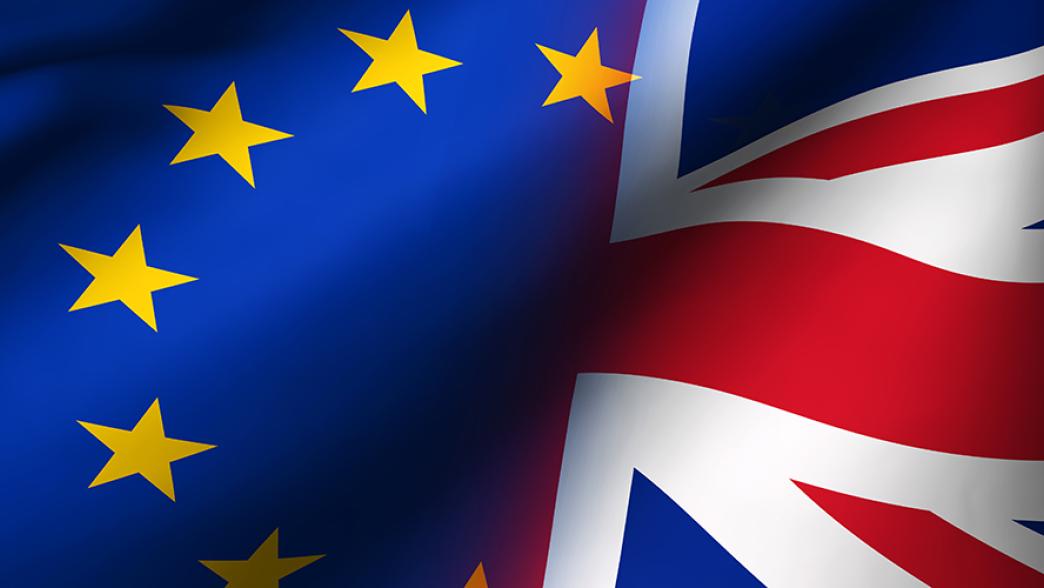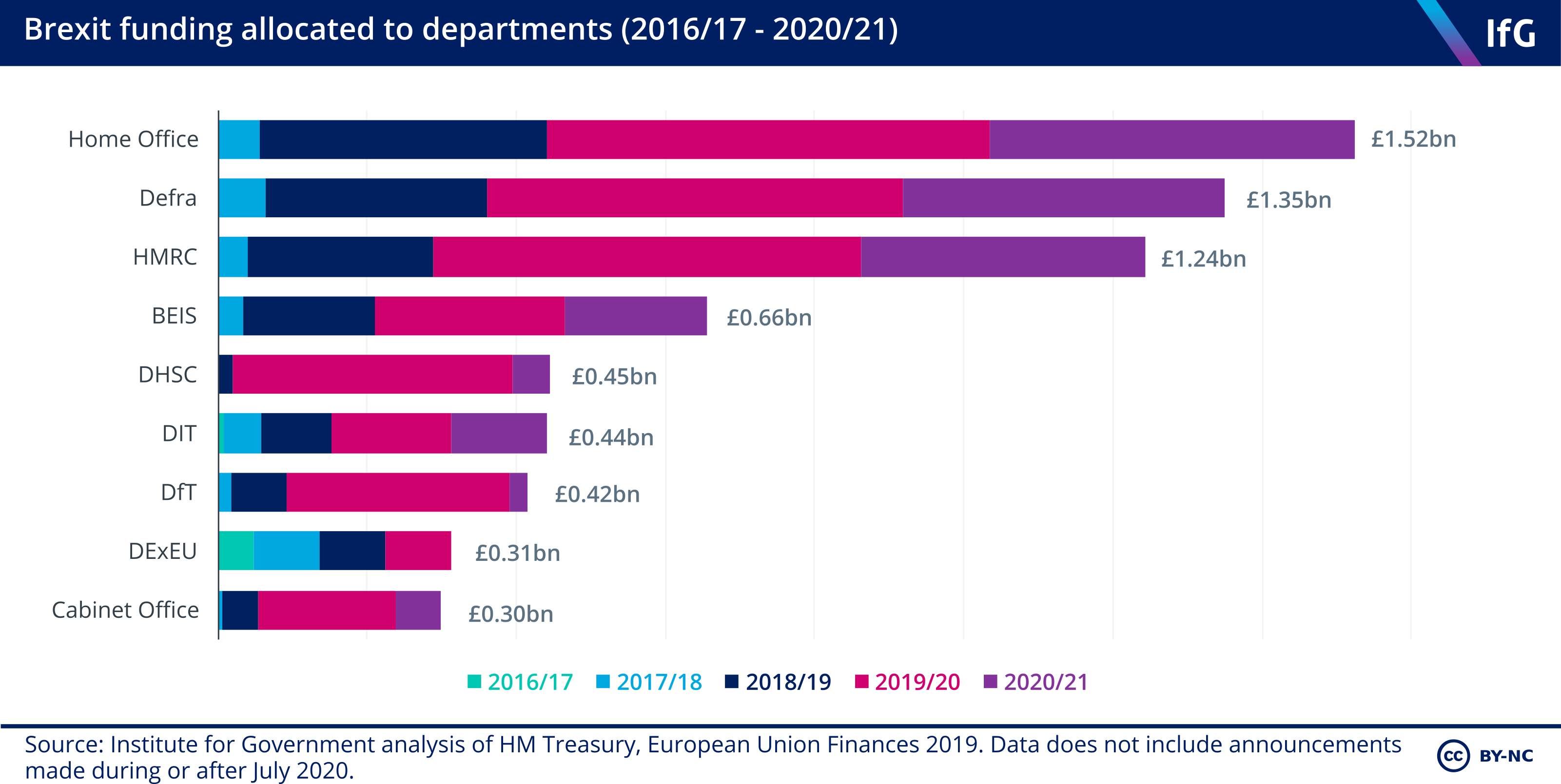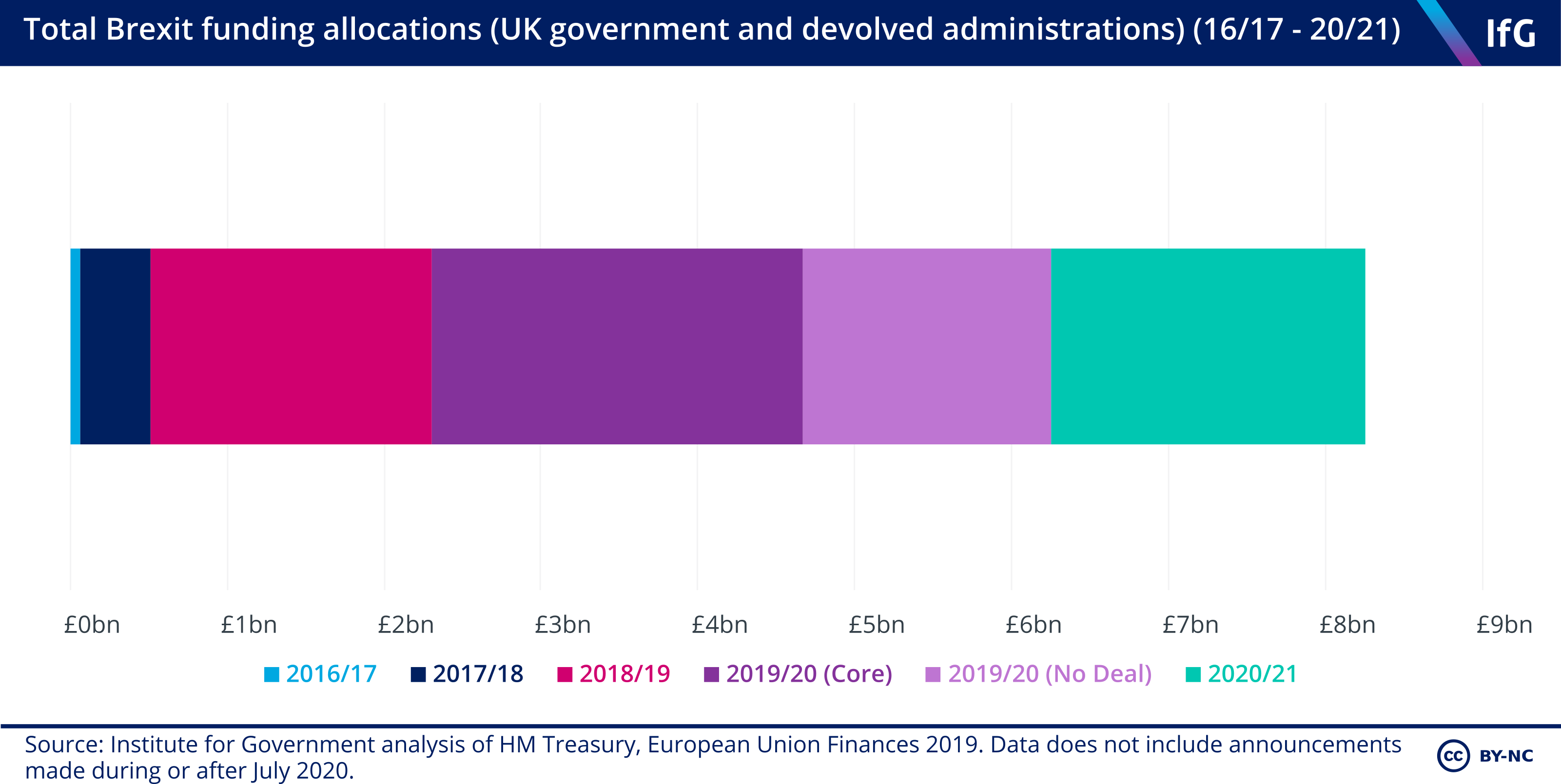Brexit spending: government preparations
By the end of 2020/21 the government is expecting to have spent up to £8.1bn on preparing for Brexit and the end of the transition period.

How much money has the government spent on Brexit preparations so far?
By the end of 2020/21 the government is expecting to have spent up to £8.1bn[1] on preparing for Brexit and the end of the transition period.
That is roughly equivalent to the cost of operating the coronavirus wage subsidy ‘furlough’ scheme for one month – or just over the cost of the two Queen Elizabeth class aircraft carriers.
The National Audit Office (NAO) estimated that at least £4.4bn had been spent by the 31 January 2020 exit date.
How does the money spent on Brexit break down?

How much of this money was allocated to no-deal preparations?
The Treasury has estimated that the government allocated around £1.6bn to departments for no-deal preparations between 2018/19 and 2019/20 – but this doesn’t tell the whole story.
Theresa May’s funding for Brexit preparations, for example, covered “all eventualities”, including but not exclusive to a no-deal Brexit. It is unclear how much of the £4.2bn allocated under her was specific to no deal.
Of the additional £2.1bn of no-deal funding that was made available by Johnson in 2019, £1.1bn was earmarked for specific projects and £1bn was left in an unallocated pot by the government, which departments could access if they were under strain. The latest figures published by HM Treasury suggest that the single largest component of no-deal spending was by the Department of Health and Social Care, which spent £330m on preparations including purchasing warehouse space and procuring freight for medicines shipments in the event of a no deal Brexit.
Meanwhile, the Department for Transport spent £280m on measures such as Operation Brock to manage traffic approaching the channel border in Kent. A total of £1.5bn was spent on no-deal preparations in 2019/20, suggesting that £600m of the £2.1bn made available by Johnson was not ultimately spent.
Was the money allocated for no-deal preparations wasted?
Although the UK avoided leaving the EU without a deal at the end of January 2020, it could still reach the end of the transition period in December 2020. In that scenario, the vast majority of preparations that were made for no deal before 31 January 2020 would be relevant. But in some areas, such as the ‘Get Ready For Brexit’ communications campaign, the government has had to allocate additional funding for the new ‘Check, Change, Go’ campaign.
Even if the UK secures a future relationship deal by the end of December 2020, many of the operational requirements of Boris Johnson’s deal are the same as the those that would have been required under a no-deal Brexit. For example, the border systems necessary are largely the same under both scenarios.
How much more money will the government spend on Brexit in future?
Although the UK has left the EU, the government still needs to do more to prepare for the changes in how the UK trades, and co-operates, with the EU after the end of the transition period.
This is likely to mean further spending beyond 2020/21, as the UK government continues to adjust to a new relationship with the EU. There are likely to be some permanently higher costs, for example in having more expensive border processes. The government has not specified how much more this is expected to cost each year.
These costs will be in addition to the financial settlement – or the so-called ‘divorce bill’ – which the UK agreed (through the Withdrawal Agreement) to pay the EU. The Treasury’s latest estimate[7] of this cost is around £30.2bn.
- HM Treasury, European Union Finances Statement 2019, 14 July 2020, www.gov.uk/government/statistics/european-union-finances-statement-2019
- Brecknell S, Autumn Statement vows £400m for key Brexit departments – as union warns of exit "on the cheap", Civil Service World, 23 November 2016, www.civilserviceworld.com/professions/article/autumn-statement-vows-400m-for-key-brexit-departments-as-union-warns-of-exit-on-the-cheap
- Honeysett L and Brien P, Revised Government spending plans for 2017-18, House of Commons Library, 12 February 2018, https://commonslibrary.parliament.uk/research-briefings/cbp-8230/#fullreport
- HM Treasury and The Rt Hon Philip Hammond, More than £2 billion Brexit preparation funding awarded to departments for a successful EU exit, 18 December 2018, www.gov.uk/government/news/more-than-2-billion-brexit-preparation-funding-awarded-to-departments-for-a-successful-eu-exit
- Cabinet Office and The Rt Hon Michael Gove, £705 million investment for GB-EU border, press release, 12 July 2020, www.gov.uk/government/news/705-million-investment-for-gb-eu-border
- National Audit Office, The cost of EU Exit preparations, 6 March 2020, www.nao.org.uk/report/the-cost-of-eu-exit-preparations/
- HM Treasury, European Union Finances Statement 2019, 14 July 2020, www.gov.uk/government/statistics/european-union-finances-statement-2019

The government first explicitly allocated money to prepare for Brexit in the 2016 autumn statement. At that time, over £400m[2] per year was allocated to run the Department for Exiting the EU (DExEU) for each year up to 2020/21 and additional funding was allocated to the Department for International Trade and the Foreign Office to help develop their trade policy capacity.
The Treasury then allocated over £280m across all government departments[3] for the 2017/18 financial year to prepare for Brexit. That figure rose to £1.5bn in 2018/19, with a further £2bn[4] earmarked in October 2018 for the 2019/20 financial year.
In 2019, Boris Johnson allocated another £2.1bn (to be spent in 2019/20) as part of no-deal preparations.
In the autumn spending round of 2019, the then Chancellor Sajid Javid committed an additional £2bn to Brexit preparations for 2020/21.
This £2bn mainly ensured that departments that had received extra money for Brexit preparations in 2019/20 would receive the same amount in 2020/21. However, there were also budget increases for the Department for Environment, Food and Rural Affairs (Defra) and HM Revenue and Customs (HMRC). It also included work on replacements for EU policies, such as the £20m to start work on the UK’s replacement for the EU’s Common Agricultural Policy (CAP), but much of the extra money was allocated to adjusting to new long-term costs, including a more complex customs and border system.
In July 2020, the government announced that an additional £705m would be made available in 2020/21[5] to help prepare the GB–EU border. These funds have been divided between specific projects, including £470 million for port and inland infrastructure and £235 million for staffing and IT.
What has the Brexit preparations money been spent on?
The Home Office, Defra and HMRC have received the largest share of government funds, with those departments receiving £1.52bn, £1.35bn and £1.24bn respectively (in 2020/21 prices).
According to the NAO[6], departments have spent money on staffing (£1.9bn), activities such as building new systems (£1.5bn) and external advice (£288m).
The government has also reported specific uses of money. For example, the greatest beneficiaries of Brexit spending have been departments with a key role at the border (£4.11bn alone has gone to the Home Office, Defra and HMRC). As of the start of 2019, the Home Office had hired 600 extra Border Force officers and HMRC has hired 2,300 extra customs staff; since then, the government has announced plans to hire a further 500 Border Force officers.
The figure shows how much money has been (or is expected to be) spent on Brexit preparations by different government departments. The figures for 2018/19 and 2019/20 include both spending on core preparations and spending on getting ready for no deal.